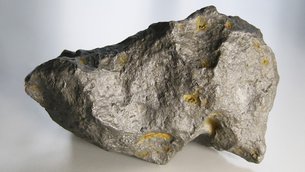Campo del Cielo, Field of the Sky, by Katie Paterson, is on
display as part of the exhibition "Curiosity: Art and the Pleasures of
Knowing," 25 May – 15 September 2013, Turner Contemporary, Margate,
Kent, UK
Inspired by the dream of space exploration, artist Katie Paterson
imagined sending a piece of her meteorite artwork back to space in a
celebration of science, art and human technology. Her vision may just
become reality, with a little help from ESA’s can-do cargo vessel.
Paterson’s installation, Campo del Cielo, Field of the Sky, is on
display at the UK’s prestigious Turner Contemporary gallery this
summer, and features a 4.5 billion-year-old meteorite that has been
cast, melted and recast as a model of itself, retaining its original
form.
Katie describes Campo del Cielo, Field of the Sky as presenting curious visitors with a newly formed yet still ancient meteorite, imbued with cosmic history.
“The iron, metal and dust inside have been reformed, and the layers of
its cosmic lifespan – the intermixing of space and time, the billions of
years of pressure and change – have become collapsed, transformed and
then, by the hand of human technology, renewed,” she says.
While developing the concept for the installation, Katie was struck by
an idea: would it be possible to ‘close the story’ of her Campo del
Cielo meteorite by returning it back to space?
“By sending it ‘back to space’, I hope to fire the imaginations of
students, youth – anyone, really – and foster a discussion on our
relation with the wider universe,” she explains.
For ESA, meteors, meteorites and asteroids are crucial to the scientific
understanding of our Solar System, and they are central to numerous
Agency activities such as the Rosetta comet mission, future robotic
missions to asteroids, near-Earth object studies, Space Situational
Awareness and even potential human missions beyond the Earth, Moon and
Mars.
“Scientists recognise comets, meteorites and asteroids as the debris
left over from the formation of our Solar System,” says Dr Detlef
Koschny, responsible for near-Earth object activities at ESA’s Space
Situational Awareness office.
“As such, studying them up close, if they fall to Earth, or deep in space, via telescopes or with spacecraft – like ESA’s Rosetta – is vital to understanding how planets and our Solar System emerged.
So, really, objects like this bit of meteorite symbolise a lot of what we are trying to achieve.”
“As such, studying them up close, if they fall to Earth, or deep in space, via telescopes or with spacecraft – like ESA’s Rosetta – is vital to understanding how planets and our Solar System emerged.
So, really, objects like this bit of meteorite symbolise a lot of what we are trying to achieve.”
Earlier this year, Katie contacted ESA to enquire if it would be
possible to send a symbolic piece of her meteorite to the International
Space Station as a way to support public outreach and awareness of the
intersection between science and art.
ESA agreed, and has provisionally allocated space on the next Automated Transfer Vehicle, Georges Lemaître,
due to voyage to the orbital outpost in 2014. A small sample of the
meteorite will be carefully assessed for flight qualification, and if it
passes, can be delivered ‘back to space’ to the Station.
“I hope this helps inspire people everywhere to think about the really big questions: the origin of life, the natural history of our Solar System and home planet, and our relationship with time, both geological and cosmic,” says Detlef.
“These are important questions, and space exploration together with art are helping us answer them.”
“I hope this helps inspire people everywhere to think about the really big questions: the origin of life, the natural history of our Solar System and home planet, and our relationship with time, both geological and cosmic,” says Detlef.
“These are important questions, and space exploration together with art are helping us answer them.”
Editor’s note: News and updates on this unique collaboration will be published later in the ATV blog.
More Information
Campo del Cielo, Field of the Sky
Curiosity: Art and the Pleasures of Knowing
25 May – 15 September 2013
Turner Contemporary
Margate, Kent, UK
http://www.turnercontemporary.org
Curiosity: Art and the Pleasures of Knowing
25 May – 15 September 2013
Turner Contemporary
Margate, Kent, UK
http://www.turnercontemporary.org
30 July 2013 - 15:00 - Exhibiting artist Katie Paterson talks about her work Campo del Cielo, Field of the Sky – a meteorite she has melted down and reformed for a trip back into orbit
ESA
Guillermo Gonzalo Sánchez Achutegui
ayabacgmail.com
ayabac@hotmail.com
ayabac@yahoo.com



No hay comentarios:
Publicar un comentario